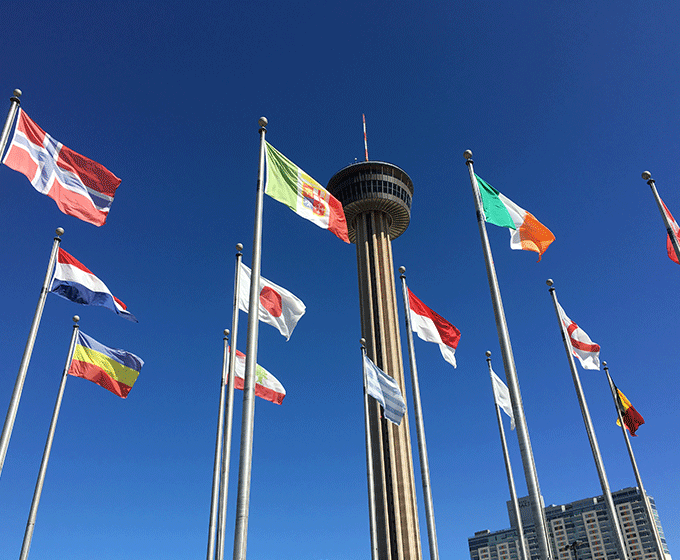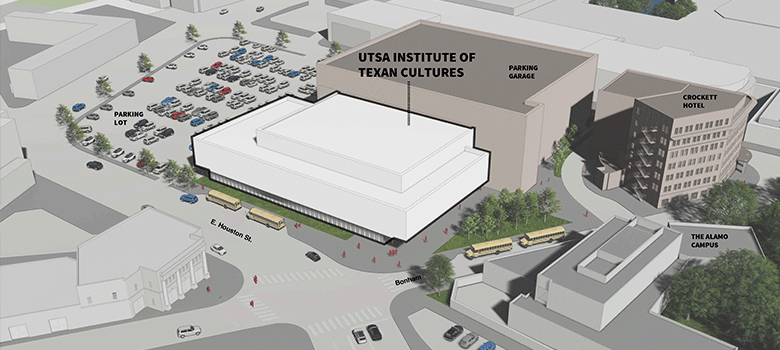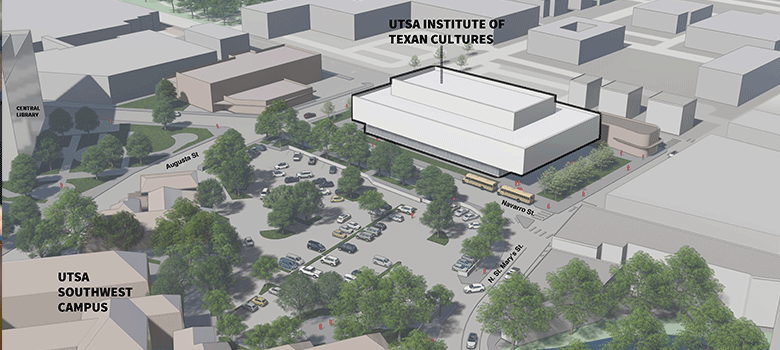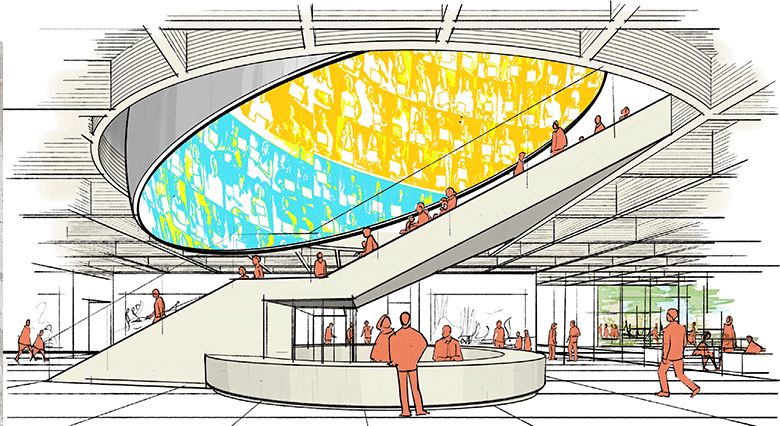
APRIL 3, 2024 — The University of Texas at San Antonio (UTSA) today announced a series of strategic next steps to realize the Institute of Texan Cultures (ITC) Centennial 2068 vision and ensure the museum’s sustainability as the preeminent venue for sharing the stories of the people who call Texas home, providing connection and insight into the past, present and future.
The university has a deep commitment to the ITC museum as a gathering place for those who love Texas history, for students to learn about the state’s past and present, and for researchers to make new discoveries that advance the knowledge of what it means to be a Texan.
“UTSA is entrusted with the stewardship of the ITC museum. We remain deeply committed to advancing its mission, honoring its past and creating a new, engaging experience that Texans of all ages can enjoy through the 2068 centennial,” said UTSA President Taylor Eighmy. “To realize that important future, we must proceed on a thoughtful path forward to maximize current opportunities that will allow us to properly preserve the museum’s current exhibits while building a new museum that will serve and educate visitors for decades to come.”
Beginning in 2021, the university engaged in significant community engagement, visioning and evaluative processes to understand how to advance the financial well-being and accessibility of the museum to ensure its success. The next steps include three strategic efforts: relocating the ITC museum to a temporary site, finalizing the location for a permanent home, and maximizing the benefit of the land at the Hemisfair Campus to support the future museum.
As the Texas Pavilion—which serves as the current home to the ITC—continues to face deteriorating facilities and costly repairs, the university, with the guidance of leading experts, has determined that preserving the museum’s historic archives and exhibits would be best accomplished by relocating to a temporary facility until a permanent museum can be constructed in the next few years.
UTSA has secured space on the first floor of the Frost Tower that will serve as the ITC museum’s temporary home for approximately the next five years. The location is easily accessible to visitors in downtown San Antonio and offers an engaging setting to host curated museum visits.
“Since its opening more than 50 years ago, the ITC has showcased the unique beauty of the many cultures that comprise Texas. Our goal is to provide an updated experience to reconnect with the community and connect with new visitors,” said Monica Perales, associate vice provost for the Institute of Texan Cultures. “The ITC museum’s collections are central to our ability to tell the rich stories of Texas, and they will continue to be vital to how we connect with the public. Our new space will allow us to share these precious artifacts with the community as we rotate them through our new space.”
“A dynamic schedule of changing exhibits developed collaboratively with community partners will illuminate the intersections between groups, showcasing the vibrant spectrum of cultural expression within Texas. Our temporary location will help us do this, providing a compelling destination for visitors while increasing our visibility as we continue to progress on our long-term plans,” added Perales.
The Frost Tower location will offer an engaging museum experience and will leverage nearby cultural assets, including the San Pedro Cultural Creek Park, to enhance the visitor experience. The university has additionally secured 25,000 square feet of climate-controlled storage space to safeguard objects and archives not currently on display. While moving collections to this storage facility, museum staff will continue to update the inventory of all collection items.
The museum facility in the Texas Pavilion on the Hemisfair Campus will conclude operations and close in May. The museum is expected to reopen in its temporary space in early 2025.

If the museum were to locate near the Crockett Hotel, it could tap into the 2.5 million guests who visit the Alamo each year.
While the ITC museum transitions to its interim home in Frost Tower, UTSA is continuing to explore location options for the construction of a permanent museum. Currently, after reviewing expert reports on several sites, UTSA’s favored location is adjacent to the Crockett Hotel, with an alternate site being considered at the UTSA Southwest Campus.
At either of these locations, the university envisions a new museum that will showcase Texan cultures to a broader audience through engaging, community-oriented programming.
UTSA is close to concluding the due diligence period for the Crockett property, an option that could allow the university to tap into the 2.5 million guests who visit the Alamo each year, bringing in more visitors to experience the ITC’s collections.
If an agreement is reached regarding use of the Crockett property, the university is exploring the option to build a 65,000 square-foot, state-of-the-art immersive museum, as well as an adjoining parking facility. The multi-story museum would include various engagement spaces, with the conceptualized museum building upon the rich architectural history of the Texas Pavilion.
If, after conclusion of due diligence, UTSA decides not to pursue the Crockett site, UTSA’s Southwest Campus remains a top choice for the new museum’s location. The proposed site at 1123 Navarro Street would allow for the new museum to complement the existing facilities at the Southwest Campus, where all regular operations, including classes and exhibitions, would continue. The Southwest Campus is home to UTSA’s growing academic and community arts programming and is located in close proximity to many cultural destinations—including the San Antonio Public Library and the Tobin Performing Arts Center—making it an ideal alternate site for co-location with the ITC museum.

The second option UTSA is exploring is locating the museum to the UTSA Southwest Campus.
“Following our successful community visioning process, we are progressing to bring the public’s feedback to life,” said Heather Shipley, UTSA interim provost and executive vice president for Academic Affairs. “Our shared vision for the future of the ITC is to create a bustling hub of activity and learning for all in our community and beyond to understand and experience the tapestry of diverse cultures that make up the great state of Texas. We are thrilled to have such exciting options for locations that will help to establish a deeper connection to our community.”
As planning for the new museum moves forward, the university will continue to engage community stakeholders as it delivers on a new vision for the museum. Additionally, the university will identify ways to honor the lasting legacy of trailblazing architect William “Willie” M. Peña, who helped design the Texas Pavilion, where the Institute of Texan Cultures is currently housed.
The university is exploring potential opportunities both at Hemisfair and at the new museum to recognize his significant contributions as a prominent Mexican American architect of the 20th century.
“We are grateful to the many museum experts who have been engaged throughout the visioning and evaluative processes,” said Perales. “The valuable insight provided from community stakeholders, museum experts and long-time supporters of the ITC has been essential to developing the vision for the future of the ITC museum.”

This conceptual interior art draws inspiration from the Texas Pavilion with a reimagined dome show.
With the ITC relocating out of the Texas Pavilion, the university has begun to look at the future of the Hemisfair Campus and how to best maximize and monetize resources to support the temporary and permanent homes of the ITC. Through a careful review of consultant reports, it has been determined that redeveloping the land at Hemisfair will best serve the future of the museum, the university and the community. To accomplish highest use of the land requires removal of the Texas Pavilion.
This past February, The University of Texas System Board of Regents conditionally approved granting an exclusive option to the City of San Antonio to purchase or lease approximately 13.59 acres located on the Hemisfair campus for a potential downtown revitalization project. This Memorandum of Understanding between UTSA and the city advances the university’s due diligence process for evaluating feasible scenarios for the future of the ITC museum.
In order to be as flexible as possible as next steps are evaluated, the university will issue a Request for Proposals to remove the Texas Pavilion, ensuring plans can move forward depending on how the land is eventually redeveloped. UTSA will continue to work directly with the Texas Historical Commission to ensure that the legacy of the Texas Pavilion is properly documented and celebrated.
“The ITC museum is an important part of San Antonio’s history and means so much to our community,” said Veronica Salazar, UTSA executive vice president for Business Affairs and chief enterprise development officer. “By maximizing the benefits of the land, we can support the best future for the museum. Moving forward in this way, we can bring a new ITC museum to San Antonio and create memories for generations to come.”
The next steps for the ITC museum are the result of several years of thoughtful work, beginning in 2021 with a year-long community visioning process that explored the future of the museum. This broad and participatory project resulted in three proposed scenarios for the ITC museum, including the option of relocating outside of Hemisfair. Those three scenarios were thoroughly explored, culminating in an evaluative report released in fall 2023.
Moving forward, the university is committed to advancing the ITC Centennial 2068 initiative by bringing to life one of the steering committee’s scenarios. Regular updates will continue to be provided to the UTSA and San Antonio communities as the vision for the future museum progresses.
UTSA Today is produced by University Communications and Marketing, the official news source of The University of Texas at San Antonio. Send your feedback to news@utsa.edu. Keep up-to-date on UTSA news by visiting UTSA Today. Connect with UTSA online at Facebook, Twitter, Youtube and Instagram.
Annual Giving will host a First Day of School celebration to welcome students back to campus. We will have giveaways and photo opportunities.
Sombrilla Plaza, Main CampusEnjoy snacks while connecting with Adobe reps and student ambassadors. Download or log into the Adobe Express app to snag swag and unlock exclusive back-to-school templates. It’s a fun, fast way to get creative and start the school year with bold moves.
Central Plaza, Main CampusCelebrate the merger of UTSA and UT Health San Antonio with a pop-up featuring free t-shirts, exclusive swag, and interactive photo opportunities. Open to all students, faculty and staff. Supplies are limited!
Sombrilla Plaza, Main CampusHuddle Against Hunger is a fundraising competition with Texas State that benefits our Roadrunner Pantry. Donations this week will help UTSA earn additional prize monies provided by RBFCU.
In-Person and VirtualJoin UTSA Libraries for an update on federal public access policies and how the library can assist with compliance.
Virtual EventWe invite you to join us for Birds Up! Downtown, an exciting welcome back event designed to connect students with the different departments at the Downtown Campus. Students will have the opportunity to learn about some of the departments on campus, gain access to different resources, and collect some giveaways!
Bill Miller PlazaThere are many citation managers. Which one is right for you? This workshop will explain what a citation manager is and how it can help you organize your citations, insert citations as you write your paper, and generate your bibliography.
Virtual EventThe University of Texas at San Antonio is dedicated to the advancement of knowledge through research and discovery, teaching and learning, community engagement and public service. As an institution of access and excellence, UTSA embraces multicultural traditions and serves as a center for intellectual and creative resources as well as a catalyst for socioeconomic development and the commercialization of intellectual property - for Texas, the nation and the world.
To be a premier public research university, providing access to educational excellence and preparing citizen leaders for the global environment.
We encourage an environment of dialogue and discovery, where integrity, excellence, respect, collaboration and innovation are fostered.